Identity用户管理入门一(框架搭建)
理论知识微软官方文档最完整,最详细,这里只一步步的介绍如何使用,地址:https://docs.microsoft.com/zh-cn/aspnet/core/security/authentication/?view=aspnetcore-3.1
一、新建Mvc项目

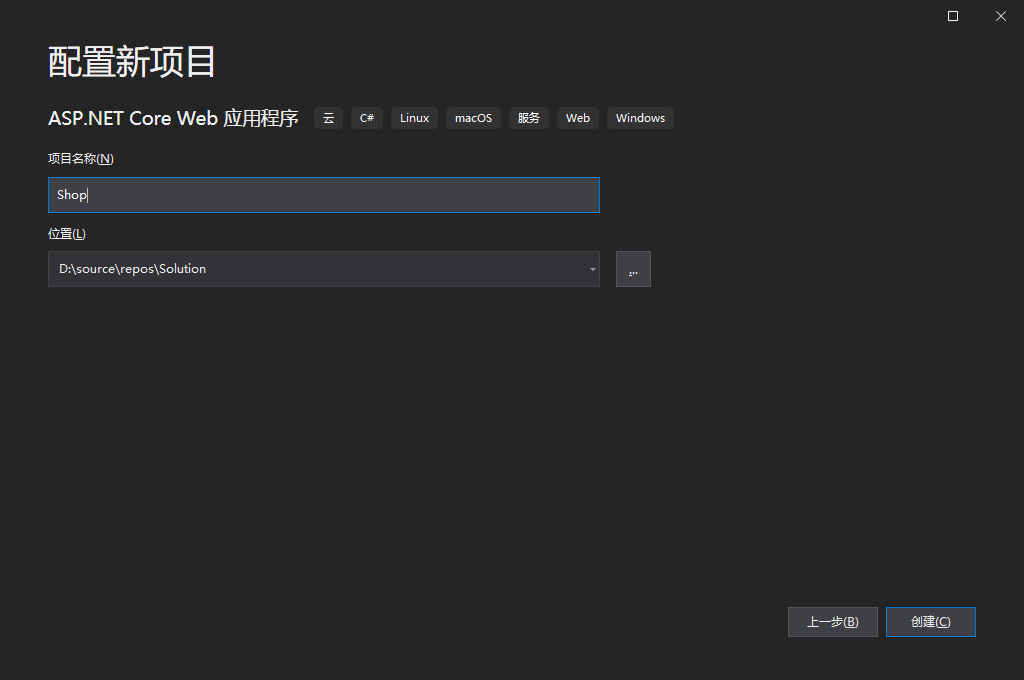
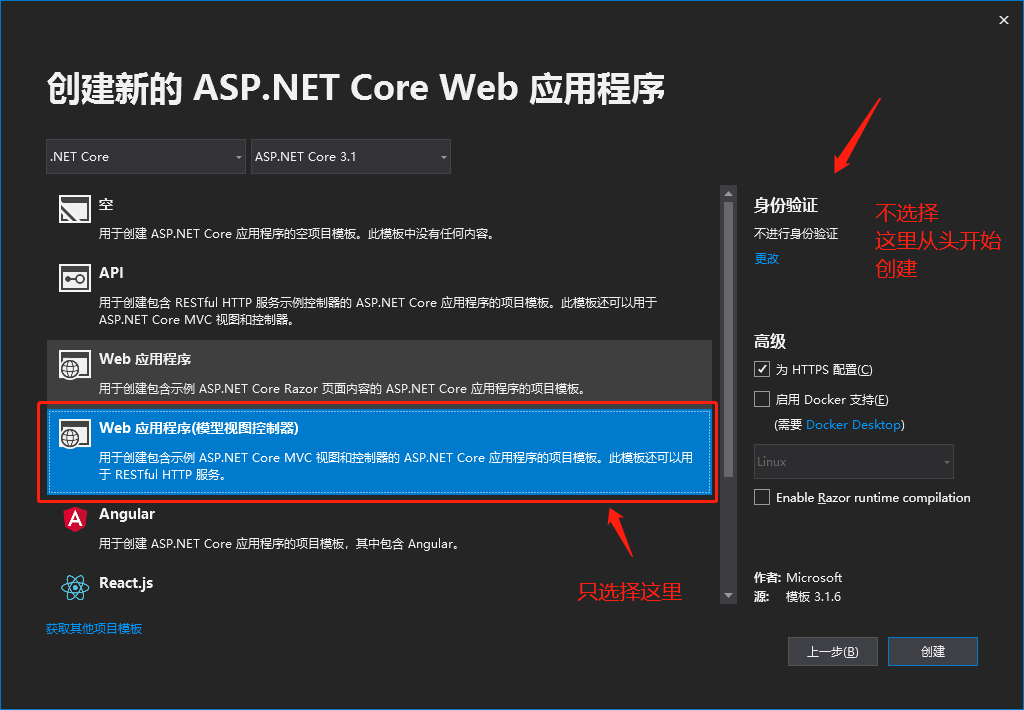
二、加入EF依赖

浏览输入entityframeworkcore安装以下三项
Microsoft.EntityFrameworkCore
Microsoft.EntityFrameworkCore.SqlServer
Microsoft.EntityFrameworkCore.Tools
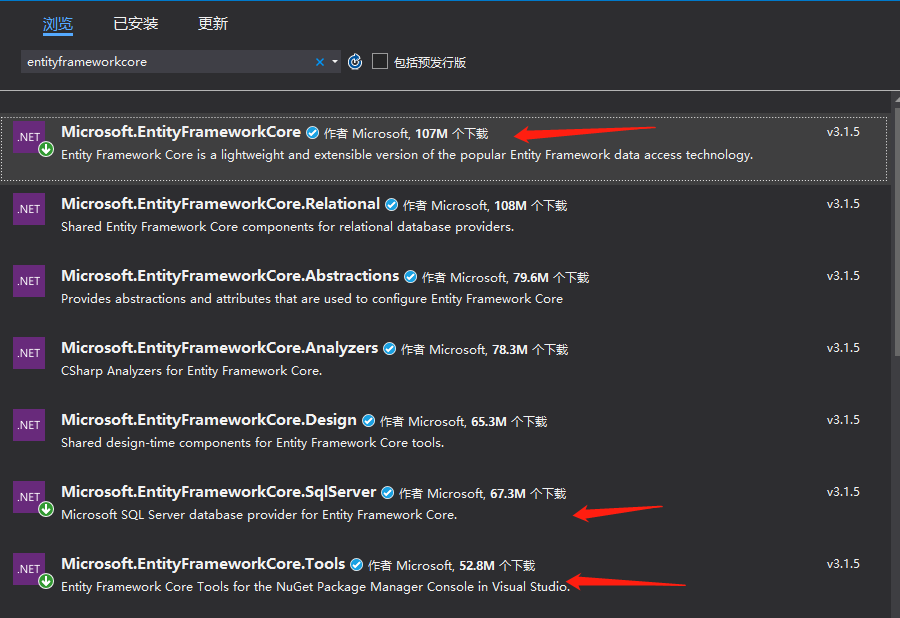
三、加入Identity依赖
同样方式将Identity依赖包加入
Microsoft.AspNetCore.Identity
Microsoft.AspNetCore.Identity.EntityFrameworkCore
Microsoft.AspNetCore.Identity.UI
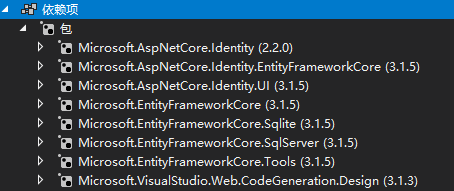
四、创建DbContext
Models目录下创建ApplicationDbContext.cs类,代码如下,注意需要继承自IdentityDbContext
using Microsoft.AspNetCore.Identity.EntityFrameworkCore;
using Microsoft.EntityFrameworkCore; namespace Shop.Models
{
public class ApplicationDbContext:IdentityDbContext
{
public ApplicationDbContext(DbContextOptions<ApplicationDbContext> options)
: base(options)
{
}
}
}
五、修改Startup增加DbContext服务,
public void ConfigureServices(IServiceCollection services)
{
services.AddControllersWithViews();
services.AddDbContext<ApplicationDbContext>(options =>
options.UseSqlServer(Configuration.GetConnectionString("Default"))); services.AddDefaultIdentity<IdentityUser>(options => options.SignIn.RequireConfirmedAccount = true)
.AddEntityFrameworkStores<ApplicationDbContext>();
}
六、增加Migrations并更新数据库,这里是从新建项目增加验证中复制过来的

00000000000000_CreateIdentitySchema.cs


using System;
using Microsoft.EntityFrameworkCore.Metadata;
using Microsoft.EntityFrameworkCore.Migrations; namespace WebApplication1.Data.Migrations
{
public partial class CreateIdentitySchema : Migration
{
protected override void Up(MigrationBuilder migrationBuilder)
{
migrationBuilder.CreateTable(
name: "AspNetRoles",
columns: table => new
{
Id = table.Column<string>(nullable: false),
Name = table.Column<string>(maxLength: 256, nullable: true),
NormalizedName = table.Column<string>(maxLength: 256, nullable: true),
ConcurrencyStamp = table.Column<string>(nullable: true)
},
constraints: table =>
{
table.PrimaryKey("PK_AspNetRoles", x => x.Id);
}); migrationBuilder.CreateTable(
name: "AspNetUsers",
columns: table => new
{
Id = table.Column<string>(nullable: false),
UserName = table.Column<string>(maxLength: 256, nullable: true),
NormalizedUserName = table.Column<string>(maxLength: 256, nullable: true),
Email = table.Column<string>(maxLength: 256, nullable: true),
NormalizedEmail = table.Column<string>(maxLength: 256, nullable: true),
EmailConfirmed = table.Column<bool>(nullable: false),
PasswordHash = table.Column<string>(nullable: true),
SecurityStamp = table.Column<string>(nullable: true),
ConcurrencyStamp = table.Column<string>(nullable: true),
PhoneNumber = table.Column<string>(nullable: true),
PhoneNumberConfirmed = table.Column<bool>(nullable: false),
TwoFactorEnabled = table.Column<bool>(nullable: false),
LockoutEnd = table.Column<DateTimeOffset>(nullable: true),
LockoutEnabled = table.Column<bool>(nullable: false),
AccessFailedCount = table.Column<int>(nullable: false)
},
constraints: table =>
{
table.PrimaryKey("PK_AspNetUsers", x => x.Id);
}); migrationBuilder.CreateTable(
name: "AspNetRoleClaims",
columns: table => new
{
Id = table.Column<int>(nullable: false)
.Annotation("SqlServer:ValueGenerationStrategy", SqlServerValueGenerationStrategy.IdentityColumn),
RoleId = table.Column<string>(nullable: false),
ClaimType = table.Column<string>(nullable: true),
ClaimValue = table.Column<string>(nullable: true)
},
constraints: table =>
{
table.PrimaryKey("PK_AspNetRoleClaims", x => x.Id);
table.ForeignKey(
name: "FK_AspNetRoleClaims_AspNetRoles_RoleId",
column: x => x.RoleId,
principalTable: "AspNetRoles",
principalColumn: "Id",
onDelete: ReferentialAction.Cascade);
}); migrationBuilder.CreateTable(
name: "AspNetUserClaims",
columns: table => new
{
Id = table.Column<int>(nullable: false)
.Annotation("SqlServer:ValueGenerationStrategy", SqlServerValueGenerationStrategy.IdentityColumn),
UserId = table.Column<string>(nullable: false),
ClaimType = table.Column<string>(nullable: true),
ClaimValue = table.Column<string>(nullable: true)
},
constraints: table =>
{
table.PrimaryKey("PK_AspNetUserClaims", x => x.Id);
table.ForeignKey(
name: "FK_AspNetUserClaims_AspNetUsers_UserId",
column: x => x.UserId,
principalTable: "AspNetUsers",
principalColumn: "Id",
onDelete: ReferentialAction.Cascade);
}); migrationBuilder.CreateTable(
name: "AspNetUserLogins",
columns: table => new
{
LoginProvider = table.Column<string>(maxLength: 128, nullable: false),
ProviderKey = table.Column<string>(maxLength: 128, nullable: false),
ProviderDisplayName = table.Column<string>(nullable: true),
UserId = table.Column<string>(nullable: false)
},
constraints: table =>
{
table.PrimaryKey("PK_AspNetUserLogins", x => new { x.LoginProvider, x.ProviderKey });
table.ForeignKey(
name: "FK_AspNetUserLogins_AspNetUsers_UserId",
column: x => x.UserId,
principalTable: "AspNetUsers",
principalColumn: "Id",
onDelete: ReferentialAction.Cascade);
}); migrationBuilder.CreateTable(
name: "AspNetUserRoles",
columns: table => new
{
UserId = table.Column<string>(nullable: false),
RoleId = table.Column<string>(nullable: false)
},
constraints: table =>
{
table.PrimaryKey("PK_AspNetUserRoles", x => new { x.UserId, x.RoleId });
table.ForeignKey(
name: "FK_AspNetUserRoles_AspNetRoles_RoleId",
column: x => x.RoleId,
principalTable: "AspNetRoles",
principalColumn: "Id",
onDelete: ReferentialAction.Cascade);
table.ForeignKey(
name: "FK_AspNetUserRoles_AspNetUsers_UserId",
column: x => x.UserId,
principalTable: "AspNetUsers",
principalColumn: "Id",
onDelete: ReferentialAction.Cascade);
}); migrationBuilder.CreateTable(
name: "AspNetUserTokens",
columns: table => new
{
UserId = table.Column<string>(nullable: false),
LoginProvider = table.Column<string>(maxLength: 128, nullable: false),
Name = table.Column<string>(maxLength: 128, nullable: false),
Value = table.Column<string>(nullable: true)
},
constraints: table =>
{
table.PrimaryKey("PK_AspNetUserTokens", x => new { x.UserId, x.LoginProvider, x.Name });
table.ForeignKey(
name: "FK_AspNetUserTokens_AspNetUsers_UserId",
column: x => x.UserId,
principalTable: "AspNetUsers",
principalColumn: "Id",
onDelete: ReferentialAction.Cascade);
}); migrationBuilder.CreateIndex(
name: "IX_AspNetRoleClaims_RoleId",
table: "AspNetRoleClaims",
column: "RoleId"); migrationBuilder.CreateIndex(
name: "RoleNameIndex",
table: "AspNetRoles",
column: "NormalizedName",
unique: true,
filter: "[NormalizedName] IS NOT NULL"); migrationBuilder.CreateIndex(
name: "IX_AspNetUserClaims_UserId",
table: "AspNetUserClaims",
column: "UserId"); migrationBuilder.CreateIndex(
name: "IX_AspNetUserLogins_UserId",
table: "AspNetUserLogins",
column: "UserId"); migrationBuilder.CreateIndex(
name: "IX_AspNetUserRoles_RoleId",
table: "AspNetUserRoles",
column: "RoleId"); migrationBuilder.CreateIndex(
name: "EmailIndex",
table: "AspNetUsers",
column: "NormalizedEmail"); migrationBuilder.CreateIndex(
name: "UserNameIndex",
table: "AspNetUsers",
column: "NormalizedUserName",
unique: true,
filter: "[NormalizedUserName] IS NOT NULL");
} protected override void Down(MigrationBuilder migrationBuilder)
{
migrationBuilder.DropTable(
name: "AspNetRoleClaims"); migrationBuilder.DropTable(
name: "AspNetUserClaims"); migrationBuilder.DropTable(
name: "AspNetUserLogins"); migrationBuilder.DropTable(
name: "AspNetUserRoles"); migrationBuilder.DropTable(
name: "AspNetUserTokens"); migrationBuilder.DropTable(
name: "AspNetRoles"); migrationBuilder.DropTable(
name: "AspNetUsers");
}
}
}
ApplicationDbContextModelSnapshot.cs


// <auto-generated />
using System;
using Microsoft.EntityFrameworkCore;
using Microsoft.EntityFrameworkCore.Infrastructure;
using Microsoft.EntityFrameworkCore.Metadata;
using Microsoft.EntityFrameworkCore.Storage.ValueConversion;
using Shop.Models; namespace WebApplication1.Data.Migrations
{
[DbContext(typeof(ApplicationDbContext))]
partial class ApplicationDbContextModelSnapshot : ModelSnapshot
{
protected override void BuildModel(ModelBuilder modelBuilder)
{
#pragma warning disable 612, 618
modelBuilder
.HasAnnotation("ProductVersion", "3.0.0")
.HasAnnotation("Relational:MaxIdentifierLength", 128)
.HasAnnotation("SqlServer:ValueGenerationStrategy", SqlServerValueGenerationStrategy.IdentityColumn); modelBuilder.Entity("Microsoft.AspNetCore.Identity.IdentityRole", b =>
{
b.Property<string>("Id")
.HasColumnType("nvarchar(450)"); b.Property<string>("ConcurrencyStamp")
.IsConcurrencyToken()
.HasColumnType("nvarchar(max)"); b.Property<string>("Name")
.HasColumnType("nvarchar(256)")
.HasMaxLength(256); b.Property<string>("NormalizedName")
.HasColumnType("nvarchar(256)")
.HasMaxLength(256); b.HasKey("Id"); b.HasIndex("NormalizedName")
.IsUnique()
.HasName("RoleNameIndex")
.HasFilter("[NormalizedName] IS NOT NULL"); b.ToTable("AspNetRoles");
}); modelBuilder.Entity("Microsoft.AspNetCore.Identity.IdentityRoleClaim<string>", b =>
{
b.Property<int>("Id")
.ValueGeneratedOnAdd()
.HasColumnType("int")
.HasAnnotation("SqlServer:ValueGenerationStrategy", SqlServerValueGenerationStrategy.IdentityColumn); b.Property<string>("ClaimType")
.HasColumnType("nvarchar(max)"); b.Property<string>("ClaimValue")
.HasColumnType("nvarchar(max)"); b.Property<string>("RoleId")
.IsRequired()
.HasColumnType("nvarchar(450)"); b.HasKey("Id"); b.HasIndex("RoleId"); b.ToTable("AspNetRoleClaims");
}); modelBuilder.Entity("Microsoft.AspNetCore.Identity.IdentityUser", b =>
{
b.Property<string>("Id")
.HasColumnType("nvarchar(450)"); b.Property<int>("AccessFailedCount")
.HasColumnType("int"); b.Property<string>("ConcurrencyStamp")
.IsConcurrencyToken()
.HasColumnType("nvarchar(max)"); b.Property<string>("Email")
.HasColumnType("nvarchar(256)")
.HasMaxLength(256); b.Property<bool>("EmailConfirmed")
.HasColumnType("bit"); b.Property<bool>("LockoutEnabled")
.HasColumnType("bit"); b.Property<DateTimeOffset?>("LockoutEnd")
.HasColumnType("datetimeoffset"); b.Property<string>("NormalizedEmail")
.HasColumnType("nvarchar(256)")
.HasMaxLength(256); b.Property<string>("NormalizedUserName")
.HasColumnType("nvarchar(256)")
.HasMaxLength(256); b.Property<string>("PasswordHash")
.HasColumnType("nvarchar(max)"); b.Property<string>("PhoneNumber")
.HasColumnType("nvarchar(max)"); b.Property<bool>("PhoneNumberConfirmed")
.HasColumnType("bit"); b.Property<string>("SecurityStamp")
.HasColumnType("nvarchar(max)"); b.Property<bool>("TwoFactorEnabled")
.HasColumnType("bit"); b.Property<string>("UserName")
.HasColumnType("nvarchar(256)")
.HasMaxLength(256); b.HasKey("Id"); b.HasIndex("NormalizedEmail")
.HasName("EmailIndex"); b.HasIndex("NormalizedUserName")
.IsUnique()
.HasName("UserNameIndex")
.HasFilter("[NormalizedUserName] IS NOT NULL"); b.ToTable("AspNetUsers");
}); modelBuilder.Entity("Microsoft.AspNetCore.Identity.IdentityUserClaim<string>", b =>
{
b.Property<int>("Id")
.ValueGeneratedOnAdd()
.HasColumnType("int")
.HasAnnotation("SqlServer:ValueGenerationStrategy", SqlServerValueGenerationStrategy.IdentityColumn); b.Property<string>("ClaimType")
.HasColumnType("nvarchar(max)"); b.Property<string>("ClaimValue")
.HasColumnType("nvarchar(max)"); b.Property<string>("UserId")
.IsRequired()
.HasColumnType("nvarchar(450)"); b.HasKey("Id"); b.HasIndex("UserId"); b.ToTable("AspNetUserClaims");
}); modelBuilder.Entity("Microsoft.AspNetCore.Identity.IdentityUserLogin<string>", b =>
{
b.Property<string>("LoginProvider")
.HasColumnType("nvarchar(128)")
.HasMaxLength(128); b.Property<string>("ProviderKey")
.HasColumnType("nvarchar(128)")
.HasMaxLength(128); b.Property<string>("ProviderDisplayName")
.HasColumnType("nvarchar(max)"); b.Property<string>("UserId")
.IsRequired()
.HasColumnType("nvarchar(450)"); b.HasKey("LoginProvider", "ProviderKey"); b.HasIndex("UserId"); b.ToTable("AspNetUserLogins");
}); modelBuilder.Entity("Microsoft.AspNetCore.Identity.IdentityUserRole<string>", b =>
{
b.Property<string>("UserId")
.HasColumnType("nvarchar(450)"); b.Property<string>("RoleId")
.HasColumnType("nvarchar(450)"); b.HasKey("UserId", "RoleId"); b.HasIndex("RoleId"); b.ToTable("AspNetUserRoles");
}); modelBuilder.Entity("Microsoft.AspNetCore.Identity.IdentityUserToken<string>", b =>
{
b.Property<string>("UserId")
.HasColumnType("nvarchar(450)"); b.Property<string>("LoginProvider")
.HasColumnType("nvarchar(128)")
.HasMaxLength(128); b.Property<string>("Name")
.HasColumnType("nvarchar(128)")
.HasMaxLength(128); b.Property<string>("Value")
.HasColumnType("nvarchar(max)"); b.HasKey("UserId", "LoginProvider", "Name"); b.ToTable("AspNetUserTokens");
}); modelBuilder.Entity("Microsoft.AspNetCore.Identity.IdentityRoleClaim<string>", b =>
{
b.HasOne("Microsoft.AspNetCore.Identity.IdentityRole", null)
.WithMany()
.HasForeignKey("RoleId")
.OnDelete(DeleteBehavior.Cascade)
.IsRequired();
}); modelBuilder.Entity("Microsoft.AspNetCore.Identity.IdentityUserClaim<string>", b =>
{
b.HasOne("Microsoft.AspNetCore.Identity.IdentityUser", null)
.WithMany()
.HasForeignKey("UserId")
.OnDelete(DeleteBehavior.Cascade)
.IsRequired();
}); modelBuilder.Entity("Microsoft.AspNetCore.Identity.IdentityUserLogin<string>", b =>
{
b.HasOne("Microsoft.AspNetCore.Identity.IdentityUser", null)
.WithMany()
.HasForeignKey("UserId")
.OnDelete(DeleteBehavior.Cascade)
.IsRequired();
}); modelBuilder.Entity("Microsoft.AspNetCore.Identity.IdentityUserRole<string>", b =>
{
b.HasOne("Microsoft.AspNetCore.Identity.IdentityRole", null)
.WithMany()
.HasForeignKey("RoleId")
.OnDelete(DeleteBehavior.Cascade)
.IsRequired(); b.HasOne("Microsoft.AspNetCore.Identity.IdentityUser", null)
.WithMany()
.HasForeignKey("UserId")
.OnDelete(DeleteBehavior.Cascade)
.IsRequired();
}); modelBuilder.Entity("Microsoft.AspNetCore.Identity.IdentityUserToken<string>", b =>
{
b.HasOne("Microsoft.AspNetCore.Identity.IdentityUser", null)
.WithMany()
.HasForeignKey("UserId")
.OnDelete(DeleteBehavior.Cascade)
.IsRequired();
});
#pragma warning restore 612, 618
}
}
}
PM> update-database
Build started...
Build succeeded.
Done.
复制到本项目后直接更新数据库,目前项目框架已经搭建好,数据库表如下
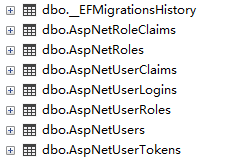
Identity用户管理入门一(框架搭建)的更多相关文章
- Identity用户管理入门六(判断是否登录)
目前用户管理的增删改查及登录功能已经全部实现,但存在一个问题,登录后要取消登录按钮显示退出按钮,未登录应该有注册按钮,现实现过程如下 一.Startup.cs中增加服务 app.UseAuthenti ...
- Identity用户管理入门二(显示用户列表)
在Controllers中新建AccountController,并在构造方法(函数)中注入SignInManager,UserManager UserManager 用户管理(注册,查找,修改, ...
- Identity用户管理入门七(扩展用户字段)
在实际使用时会发现很多字段在IdentityUser中并不存在,比如增加生日,地址等字段,可在模型类中实现自己的模型并继承自IdentityUser,需要修改的代码为以下类 一.新增模型 using ...
- Identity用户管理入门三(注册用户)
用户注册主要有2个方法,1.密码加密 2.用户注册 3.ASP.NET Core Identity 使用密码策略.锁定和 cookie 配置等设置的默认值. 可以在类中重写这些设置 Startup(官 ...
- Identity用户管理入门五(登录、注销)
一.建立LoginViewModel视图模型 using System.ComponentModel.DataAnnotations; namespace Shop.ViewModel { publi ...
- Identity用户管理入门四(修改、删除用户)
修改用户不能修改Id及用户名所以创建视图模型时需要去除,新增用户跟修改用户基本视图一直,所以不再做演示 一.新建UpdateUserViewModel视图模型 using System.Compone ...
- ASP.NET MVC+EF框架+EasyUI实现权限管理系列(1)-框架搭建
原文:ASP.NET MVC+EF框架+EasyUI实现权限管理系列(1)-框架搭建 ASP.NET MVC+EF框架+EasyUI实现权限管系列 (开篇) 前言:这篇博客开始我们便一步一步的来实现这 ...
- 一个用户管理的ci框架的小demo--转载
一个ci框架的小demo 最近在学习ci框架,作为一个初学者,在啃完一遍官方文档并也跟着官方文档的例程(新闻发布系统)做了一遍,决定在将之前练习PHP与MySQL数据库的用户管理系统再用ci框架实现一 ...
- oracle用户管理入门
1.创建一个新用户(普通) create user 用户名 identified by 密码 示例,创建一个名叫小明的用户,密码为xm 2.以管理员的身份给普通用户修改密码(当普通用户忘掉自己的密码时 ...
随机推荐
- [源码解析]机器学习参数服务器ps-lite(4) ----- 应用节点实现
[源码解析]机器学习参数服务器ps-lite(4) ----- 应用节点实现 目录 [源码解析]机器学习参数服务器ps-lite(4) ----- 应用节点实现 0x00 摘要 0x01 基础类 1. ...
- Android中的一些小细节
在代码中获取到的padding .margin.getWidth.event.getX.context.getResources().getDimensionPixelSize(R.dimen.key ...
- Java时间类从此变得清晰明了
Java时间类 Java时间类分为Date 日期类和Calendar 日历类,相信很多小伙伴在初学时会对这个两个类的用法.区别以及有什么联系会感到疑惑,似乎懂了,但又不能具体说清,今天再带你来清晰的再 ...
- OOP面向对象程序设计原则
OOP面向对象程序设计原则 开闭原则(Open Close Principle) 对扩展开放,对修改关闭 里氏代换原则(Liskov Substitution Principle) 继承必须确保超累所 ...
- Go语言笔记[实现一个Web框架实战]——EzWeb框架(一)
Go语言笔记[实现一个Web框架实战]--EzWeb框架(一) 一.Golang中的net/http标准库如何处理一个请求 func main() { http.HandleFunc("/& ...
- 【Java】@Scheduled常用的注解的使用
@Scheduled注解的使用 cron cron这个参数必须要接受一个cron表达式 cron表达式是个啥呢,Cron表达式是一个具有时间含义的字符串,字符串以5个空格隔开,分为6个域,格式为 X ...
- mock平台介绍和moco的简单例子
1.mock是什么?mock测试就是在测试过程中,对于某些不容易构造或者不容易获取的对象,用一个虚拟的对象来创建以便测试的测试方法.在具体的测试过程中,我们经常会碰到需要模拟数据或者接口的情况,因为环 ...
- Windows内核-7-(IRP)I/O请求包
Windows内核-7-(IRP)I/O请求包 IRP(I/O Request Packet)就是一个进行I/O操作的请求包. IRP是一个结构体,谁分配谁就得释放,通常由执行体里的管理器,获取内核驱 ...
- 《JERRY Hexo & GitHub 静态网站搭建说明》
JERRY-Hexo-GitHub <JERRY Hexo & GitHub 静态网站搭建说明> 原创内容,转载请注明出处! 一.前言 1.1 什么是 Hexo? 一个基于 Nod ...
- gitlab-ci集成SonarQube代码质量检查
SonarQube是管理代码质量一个开放平台,可以快速的定位代码中潜在的或者明显的错误. docker安装 1.拉取 postgres:docker pull postgres:10 2.拉取sona ...
